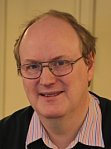B9: Spin pumping and tunneling in ferromagnetic oxide hetero- and hybrid structures
The project investigates two different transport phenomena based on spin and/or magnetism in oxide hetero and hybrid structures. One of these phenomena is the spin-pumping where we put special emphasis on spin-pumping into and through complex oxides. In recent years spin-pumping from ferromagnetic oxides into metals has been studied extensively. Different groups have shown that by ferromagnetic resonance in thin yttrium iron garnet (YIG) films spin currents can be injected into thin films of Pt or other materials where they can be detected via the inverse spin-Hall-effect.
Typically these materials were metals. In the last period of funding we have shown that spin-pumping can not only be done with an oxide as a source but also spin currents can be injected into a complex oxide (in our case SrRuO3 above its Curie temperature) and therein cause an inverse spin-Hall-effect. In this case the source of spin pumping could be YIG as well as La0.7Sr0.3MnO3.
We will now extend these experiments to other oxides. In addition we will investigate spin-pumping in fully epitaxial oxide stacks with special attention to the influence of antiferromagnetic interlayers for which recently a remarkable increase of spin-pumping in YIG/AFM/Pt could be demonstrated.
Furthermore we were able to show in the last period that the tunneling anisotropic magnetoresistance (TAMR, up to now limited to a few percent) can be increased to more than 60% in epitaxial oxide systems. Here we use structures consisting of a ferromagnetic oxide with an epitaxial tunnel barrier and a non-magnetic metal as a counterelectrode.
Besides the influence of the barrier and counterelectrode we now plan to investigate the influence of ferroelectric barriers. As the magnitude and signature of TAMR mainly depend on the electronic states at the interface between the magnetic oxide and the barrier we expect that by direct influence of the ferroelectric polarization and the magnetoelectric coupling further enhancement or modulation of the effect is possible, even without a second magnetic electrode.
|
Prof. Dr. Georg Schmidt ⇒
georg.schmidt@physik.uni-halle.de phone: +49 (0) 345/55 25320 fax: +49 (0) 345/55 27034 |

|


